Book Review: “Don’t Drink Your Milk!“ by Frank A. Oski
Another doctor recognized problems caused by milk and provided short descriptions for 32 of the many studies he had analyzed.
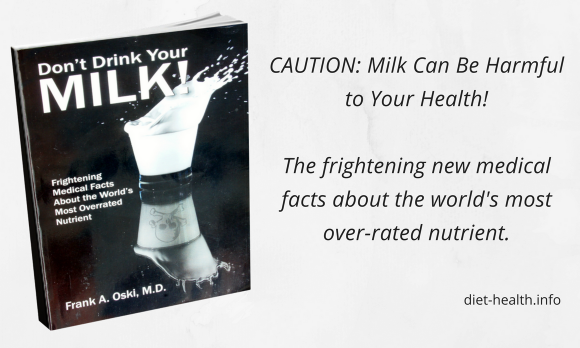
Table of contents
- Conclusion
- 1. Summary
- 2. Book Review
- 2.1."Milk Is a Natural," p. 7
- 2.2. Paying Premium for a Quart of Intestinal Gas!, p. 11
- 2.3. Don't Cry Over Spilled Milk, p. 21
- 2.4. Can Fat Be Fatal?, p. 33
- 2.5. Alternatives—Two Sides To The Story, p. 43
- 2.6. The Calcium Scare, p. 53
- 2.7. Do You Really Want a Résumé of the Cow's Lunch?, p. 57
- 2.8. “Beware of the Cow,” p. 65
- 2.9. “Milk has Something for Everybody,” p. 73
- 2.10. Milk and Tension-Fatigue Syndrome, p. 79
- 2.11. “What to Do instead?” p. 83
- Research Appendix, p. 95
- References and Reading Suggestions, p. 118
- About the Author, p. 126
- 3. About the book
Conclusion
I have to admit that I find the book "Milk Better Not!", by Maria Rollinger more comprehensive and better suited for Europe. A link to my review of this book can be found here. Nevertheless, this book by Prof. Dr. Frank Aram Oski (1932-1996) informs you about other important aspects on this subject. As a pediatrician and hematologist, he headed the Pediatrics Department of the State University of New York and later at Johns Hopkins University School of Medicine.
With all of his works and experiences, Dr. Oski became THE voice regarding diseases, nutrition and hygiene of children in the U.S.
But that wasn’t all, he was also an expert on the diet of adults. He published this book shortly before his untimely death from prostate cancer. His insight regarding milk came too late for him but his research is amazingly extensive.
He calls it “frightening facts about the world's most overrated nutrient.” I have therefore also linked the listed scientific works with the summary (abstract) as much possible at the end of this review.
1. Summary
This book explains why cow's milk is unhealthy and why many people may not know why. Any milk from another species is not healthy. The author, however, does not mention the important issue of the numerous "growthhormones" contained in cow's milk.
Iron deficiency in children with high milk consumption was an indication of problems with cow's milk. At that time cow's milk was still used as a supplementary food.
Comparison of minerals in human milk to cow's milk (mg/dl)
The iron content of cow's milk (a value of 60 µg/dl) is substantially less than in breast milk (74 µg/dl).
Vegetables (such as spinach, chard or mangold) contain at least twice as much iron and up to 30 times more than in milk. Vegetables also often contain more calcium if you consider the important net intake figure.
| Comparison of minerals in human milk to cow's milk (mg/dl) | ||
| Element | Human | Cow's milk |
| Ca (Calcium) | 30 | 120 |
| P (Phosphorus) | 14 | 94 |
| K (Potassium) | 51 | 150 |
| Na (Sodium) | 15 | 45 |
| Cl (Chlorine) | 41 | 106 |
| Mg (Magnesium) | 4 | 12 |
| S (Sulfur) | 14 | 33 |
| Table from the book "Milk and Dairy Products in the Diet of Humans", Prof. Dr. Edmund Renner, 3rd edition 1977, p. 152 and 156. | ||
Vegan.de said the following (May 31, 2002): Dr. Renner is considered milk pope and has conducted diverse studies on alleged osteoporosis prevention through cow's milk.
This is followed by the study results from International Dairy Journal 1991/1 / p. 77-82. Next is a damning indictment such as this study at the Justus Liebig University Giessen. I have converted the mg/l into mg/dl, so they are comparable in the usual way, i.e. mg/100g and fake nothing.
Prof. Dr. Ooski M.D., who was quite a prominent scientist, first explains why milk and dairy products have become our staple diet. He gives examples of the influence of the dairy industry and dairy lobby, and points out what kind of “big business” it is, and makes mention of the massively influenced policy agenda. He provides facts and figures. A more critical attitude towards milk came about slowly because diseases that were caused by milk consumption were eventually discovered:
Lactose intolerance
He begins with lactose intolerance. This applies to most people, considering the world as a whole.
There are two ethnic groups in Nigeria for example and 99% of the people belonging to those groups showed lactose intolerance after the age of three.
But northern Europeans, their emigrants, and the mixed population of southern Europe rarely suffered from lactose intolerance.
This also applies to some non-European groups, such as in Africa or India. For a person who tolerates milk well, lactose intolerance is irrelevant, but all other disadvantages also apply to these individuals.
Milk allergies
In the next part of the book Dr. Oski writes about milk allergies and these have nothing to do with lactose intolerance.
Such allergy cases are switched to soy products. However, some children react to soy with allergies as well. Since most mothers believe cow's milk is essential for their child, doctors perhaps don’t dare to suggest an alternative.
But one must always carefully ascertain no other reasons exist for these symptoms. Unfortunately, people suffer too often from unrecognized food allergies. You should always check first if milk is the cause of any symptom.

Food allergies, and especially milk, are often not IgE-dependent. Gluten intolerance (celiac disease) is also one of the immunological, non-IgE-caused food intolerances. Antibodies in the blood rarely indicate more besides the fact that the person has been consuming more of that food item.
Cardiovascular disease
In the chapter “Can Fat Be Fatal?” the author points out that one million people die in the U.S. each year from cardiovascular disease. This is half of the causes of death in the United States.
To reduce the risk of atherosclerosis, stroke and heart attack, fat would have to come from plant-based products.
The author describes how only by the 1950s (after the Korean War) research found that these disease processes (pathogenesis) began in childhood if the person eats as per the traditional style in the West.

Before the problem of fat was researched in more detail, the unfortunate claim that there is too much fat in the Western diet was being circulated.
This brought on other health problems, such as diabetes. The important realization came much later that one does not have to curb one’s intake of fat, but change the biological quality of the fat consumed.
Finally, it was recognized that vegetable fats and especially vegetable proteins instead of animal proteins lead to a healthier life. The importance of certain fatty acids was recognized but now that is being overdone too...
If you don’t want to continue being a chess piece of the food industry, you should at least read the book review on "The China Study" or the book by Prof. Dr. T. Colin Campbell. But why we became so gullible is described in the book review on "Salt Sugar Fat".
Breast and prostate cancer
Next Prof. Dr. Frank A. Oski M.D. takes up the link between high milk and dairy product consumption and cancer, especially colon cancer, breast cancer and prostate cancer. He gleaned this information from numerous scientific studies, which are also separately listed in the appendix. Next is a listing of known books on the subject. After that he provides alternatives.
The consequences for babies who either don’t receive breast milk at all or aren’t breastfed long enough
As a pediatrician, he writes about the consequences for babies who either don’t receive breast milk at all or aren’t breastfed long enough. He also explains the possible consequences of the health of these children later in their lives.
Even Prof. Dr. Edmund Renner, who is also active as a proponent for the dairy industry had to concede the following in his standard work (see above):
In premature births, there are significant changes in the content of the milk, especially in regards to Cu, Mn, Si and Al, usually with increased values (Unanyan 1967). (p. 157)
On page 162 on infant feeding he says: Especially for newborn nutrition, however, a reduced mineral content of milk is considered necessary, as in the first month of life, the increased mineral intake would represent a burden on renal function
(Abe 1969, Droese u. Stolley 1972, Kagan et al. 1956, Nichols u. Danford 1966, Yamauchi u. Tsugo 1970).
Breast milk is constantly adapted to the needs of the child and it is not just the colostrum that is important for infants to thrive.
But what if a mother cannot give her baby her own breast milk?
Prof. Dr. Frank A. Oski M.D. says that today's replacements are worlds better than before, but recommends when possible to give a foster mother’s milk. Then the author explains how a mother should proceed concerning supplementary nutrition. He also takes up weaning. After that, he explains how adults and the elderly should behave regarding milk and dairy products.
Osteoporosis
In the next chapter Dr. Oski takes up the question of calcium. Calcium is important for humans. The dairy industry tells us we should meet our calcium needs with milk and dairy products.
However, enough calcium can be obtained from vegetables that in many cases contain even more usable calcium. It is easier for the human body to get calcium from vegetables, fish, nuts, etc., rather than milk.
Americans consume 807 mg of calcium just from dairy products, such as cheese, and especially older women often suffer from osteoporosis. Meanwhile, Taiwanese with 13 mg of calcium or people in Ghana with only 8 mg have much less incidence of osteoporosis and have better teeth.

If these above mentioned people were started on a traditional Western diet, their children would have a tendency to show similar rates of susceptibility to osteoporosis as we do.
The author lists good sources of calcium such as vegetables (peppers 229 mg / 100g, kale 175, and spinach 150); almonds (264 mg / 100g) and fish (sardine 382 mg / 100g). But these are exceptions, and only the better bioavailability and the high pH of vegetables and fruits make the difference.
Acne
The next section deals with the harmful substances contained in dairy products. This starts with bacteria (e.g., EHEC and Staphylococcus aureus, sometimes as a result of mastitis) that in spite of heating remain and continue to multiply. In addition, dairy products contain harmful pesticides and the hormone progesterone from pregnant cows.
It has been proven that the hormone progesterone, a progestin, can cause acne. More on that later in this article. However, after milk is fully eliminated from the diet, acne disappears after some time.
Today cows are artificially prematurely impregnated so that the milk flow stops. That is why you will also find more Progesterone in milk products.
But even babies can suffer from acne, which is called neonatal acne or acne infantum. Depending on the eating behavior of the mother this may occur in the womb. Today neonatal acne occurs in about 20 percent of newborns.
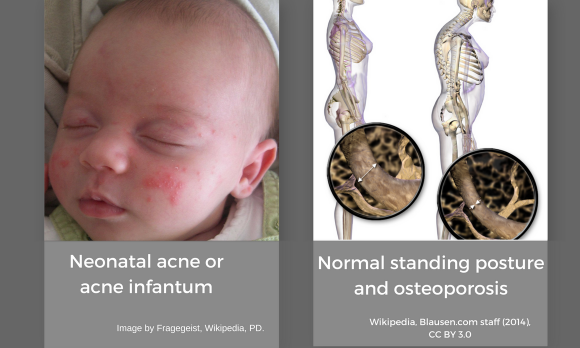
In the chapter “Beware of the Cow,” the author addresses a strong correlation made between diseases and milk consumption. But scientists, who advocate milk, doubt such correlations for understandable reasons. Since Prof. Dr. Oski M.D. is careful in his wording, he writes only about “very disturbing theories.”
Multiple sclerosis, leukemia, juvenile idiopathic arthritis
On multiple sclerosis (MS), for example, he mentions numerous large studies, which attempted to link this disease with different causes. The only thing common in all these investigations is the relation to milk consumption. If you look at individual studies, it does not stand out because other causes were also considered. Given the power of the dairy lobby, that is not enough for an official warning. The very rare amyotrophic lateral sclerosis is also linked to milk consumption.
It is established that leukemia can be caused in monkeys which consume cow's milk. As a note, most of the diseases chimpanzees may get, also occur in humans.
He further covers the relationships between milk and juvenile idiopathic arthritis (JIA). But Wikipedia still mentions “unknown cause” for this child rheumatism. This, in spite of the great successes by pediatrician Dr. J. Dan Baggett M.D. and other pediatricians who achieved successes in terms of healing by getting their patients fully off all dairy products.
A strong correlation between milk and anti-social behavior and crime can be observed in adolescents. Such young people drink up to ten times more milk than other teens. The scientists suspect a type of protein poisoning or too little nuts (for the brain). Dr. Oski also briefly shows how milk destroys teeth when used as a sleep aid to put kids to bed.
Next, the author takes up specifics about milk advertising that even the industry-friendly Federal Trade Commission (FTC) had to call false, misleading and deceptive.
The FTC even had to intervene against their own clientele and today it is only “Milk has something for everyone” because bad ingredients are perfectly okay.
He further covers how the media lives off of this industry while being under constant observation (Argus).
Tension-Fatigue Syndrome
The next chapter, “Milk and the Tension-Fatigue Syndrome,” takes up various diseases caused by milk, which are described by other doctors. This includes, for example, anxiety disorders and depression. Psychiatrist Dr. HL Newbold often sees this as a result of cow's milk allergy.
Dr. William G. Crook M.D. found food allergy as the cause in 41 of 45 children with hyperactivity or learning disabilities.
The dairy industry slowly begins to see that cow's milk is not the ideal product they’ve made it out to be. Plant-based milk imitations would be much healthier as they are found almost everywhere today.
Because you may experience serious problems later, you should abstain from all foods containing cow's milk products.
He explains the different types of milk with advantages and disadvantages including “filled milk” and milk imitations. He provides numerous examples of production methods and details on the composition of milk. He also goes into what is currently prevalent and shows ratios to previous drinking habits.
"Milk better not" - book review
| Here is the link to the book review on "Milk Better Not!", by Maria Rollinger. I consider it the best book on the subject of milk and health hazards caused by milk. She lists more than 50 scientific papers, which she evaluated for her book. Especially in the US, there are quite a number of doctors and medical professors who have written books on this subject. Each of these books takes up a slightly different aspect. I have discussed books with a scientific background or great practical knowledge of doctors. You can already find the basic arguments of the authors in the conclusion or summary. |
An exception is my book review on "MILK The Deadly Poison" by Robert Cohen because he exposed the scandal on the approval of artificial hormones in the United States. I put forward my reservations about that book in the conclusion. Even a chiropractor detailed extraordinary experiences with patients who consume milk or dairy products. See book review "NO MILK" by Dr. Daniel A. Twogood.
Parts of the book content can be found at Google Books. An interesting comparison of the statements made by scientists that are advocates of the dairy industry and independent scientists, who come to very different conclusions because of the resulting illnesses and ailments, can be found at procorn.org. You have the choice...
Contents
- "Milk Is a Natural" (Page 7)
- Paying Premium for a Quart of Intestinal Gas! (Page 11)
- Don't Cry Over Spilled Milk (Page 21)
- Can Fat Be Fatal? (Page 33)
- The Alternatives –Two Sides To The Story (Page 43)
- The Calcium Scare (Page 53)
- Do You Really Want a Résumé of the Cow's Lunch? (Page 57)
- "Beware of the Cow" (Page 65)
- "Milk Has Something for Everybody" (Page 73)
- Milk and the Tension-Fatigue Syndrome (Page 79)
- "What to Do Instead" (Page 83)
Research Appendix (Page 95)
References and Suggested Readings (Page 118)
About the Author (Page 126)
About the author
After completing medical studies in 1958, FRANK A. OSKI (1932-1996) specialized in Pediatrics. In 1963, he was appointed Professor and Chairman of the Department of Pediatrics of the State University of New York. In 1985, he attained the position of Director of Pediatrics of the John Hopkins University School of Medicine and he was elected as Physician-in-Chief for the Johns Hopkins Children's Center.
Dr. Oski has published 290 works and written 19 books. It includes standard works such as "The Whole Pediatrician Catalog or Principles and Practice of Pediatrics". He was a very respected and experienced scientist and founder of contemporary pediatrics. As a co-author, he worked from 1976 to 1991 for The Yearbook of Pediatrics. His great work is only partially described here.
For his knowledge and work Dr. Oski received, for example the E. Mead Johnson Award 1972 for exceptional work in the research of children's diseases, the Joseph W. St. Geme, Jr. Leadership Award in 1990 for “pediatric leadership,” and the same year the Ross Award for Pediatric Education (Ross Teaching Award) from the American Academy of Pediatrics (AAP), the Distinguished Graduate Award from the University of Pennsylvania School of Medicine, and the Maryland Pediatrician of the Year. In 1991 he was awarded an honorary doctorate of science by the State University of New York.
The differences in approach are distinctly visible when you compare the various books that criticize milk. Some may advocate against milk for ethical reasons, in other words animal welfare or environmental concerns regarding the destruction of forests for the growing of corn, grain and soy for the cows. Or “Milking the Public,” which shows the close ties with the major policy-makers and the public health system. However, “cheap” “me-too-books” exist as well, which merely regurgitate familiar material and classify as immitation products.
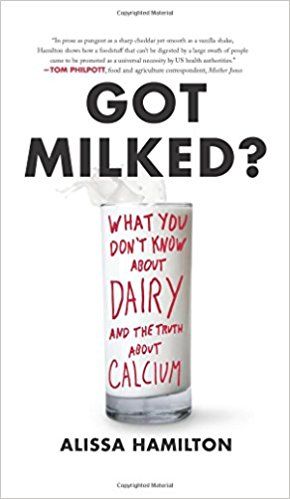 | 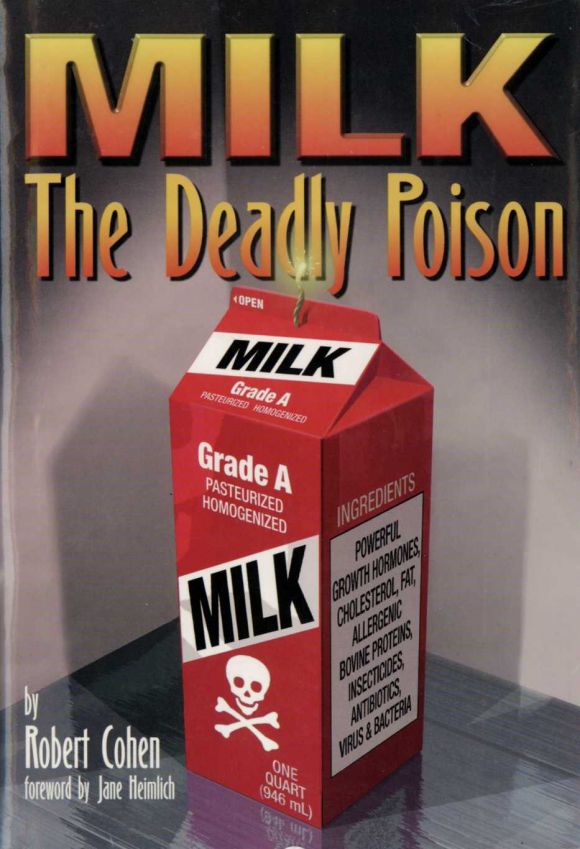 | 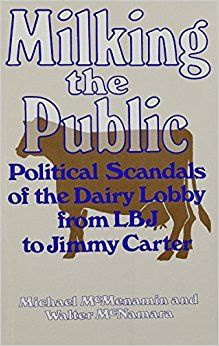 |  | 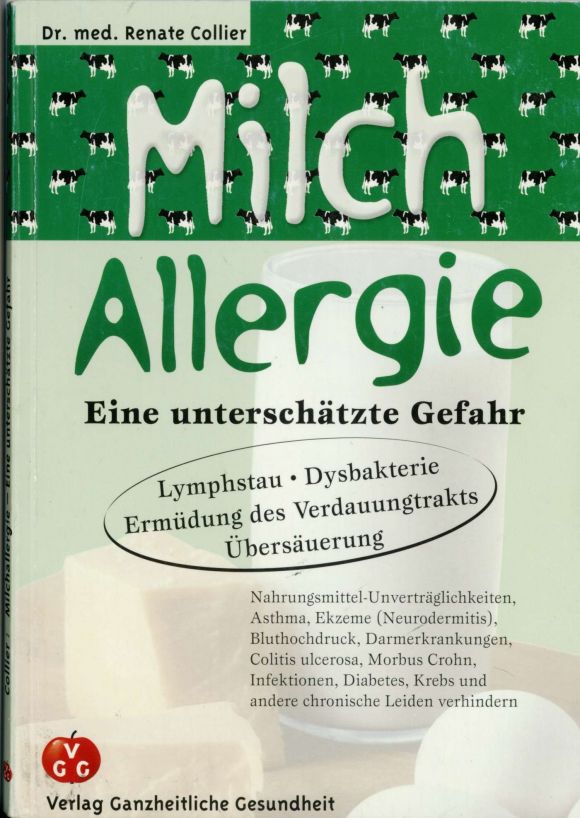 |
2. Book Review
Dr. Frank A. Oski begins by describing how his daughter came home from school one time in tears because she had responded to the following three questions with "No", but “Yes” was considered correct for the third question:
- Do you think that a rabbit can make a mitten?
- Can a fish hop like a rabbit?
- Should all boys and girls drink milk?
It’s kind of obvious from these questions what industry has a hand in it and how subtly it affects people.
To refuse milk is practically considered un-American
To refuse milk is practically considered un-American, and the teacher was of the opinion that this father was a “lunatic” of a doctor. This was because he advised against cow's milk, at least for children. Dr. Oski understood the reaction in principle because unenlightened people can only have this attitude given the intense and compelling marketing and political pressure.
This attitude, seeing milk as particularly valuable, also comes from mothers, because aggressive milk and dairy products advertising has been going on for generations.
Meyers encyclopedia, 4th Edition, 1885-1892 describes the more natural milk production from that time.
It also says: Algäuer cows remain rich in milk often up to the age of 16 years...
Today, they are lucky if they reach one third of that age.
2.1."Milk Is a Natural," p. 7
The advertisement suggests “Did you have your milk?,” “Milk is natural,” “Milk is the perfect food,” “Everyone needs milk” or even "Milk drinkers make better lovers!”. See also below.
One seventh of expenditures on food are for dairy products. This is the first rank by food category. Americans consume on average 187 kg (375 pounds) of milk products a year per person. 18 million cows in the United States provide “big business.”
Finally, more and more doctors question if cow’s milk really is that healthy.
Concerns about cow's milk
People with negative health experiences from dairy products do too.
Even more amazing: The Federal Trade Commission (FTC) published criticism. Even President Richard Nixon realized that milk is not necessarily healthy. This realization was shared also by John Connally, who was involved in a bribery scandal concerning milk prices in Texas in 1975.
Then milk consumption finally began to be linked to iron deficiency in infants and children. There were examples of cramps and diarrhea in connection with milk and various types of allergies. Early indications confirmed that atherosclerosis and heart attacks are associated with milk consumption as well.
There were so many concerns about cow's milk among pediatricians that the Committee of Nutrition of the American Academy of Pediatrics (AAP) published the article "Should Milk Drinking by Children Be Discouraged?" The statement is not a clear yes or no.
Milk comprises sugar, fat and protein with plenty of water, which in turn contains minerals, vitamins and hormones. Each of the three main components is questioned and the problems concerning them are recognized in the professional world today.
Mammals drink their mother's milk until they reach triple their birth weight. A human child reaches that after about a year.
Man is not sufficiently aware that the various mammals such as goats, elephants, cows, camels, yaks, wolves or walruses produce milk of a very different composition.
2.2. Paying Premium for a Quart of Intestinal Gas!, p. 11
Lactose is a disaccharide comprising D-galactose and D-glucose. Lactose is found only in milk. All mammals except seals, sea lions and walruses produce milk with lactose as a sugar component. The ratio of lactose: breast milk 7g /100g, cow's milk 4.8g /100g.
We cannot absorb lactose. Therefore, the body of an infant produces the enzyme lactase, which breaks down lactose. If this enzyme is lacking or there is too little of it, then the lactose enters the colon where bacteria break it down. This produces a lot of gas.
The majority of the world’s population is lactose intolerant and suffers from the consumption of milk and dairy products.
Lactose intolerance
Wikipedia: In case of defective lactase activity, undigested lactose reaches into the colon where it is absorbed and fermented by intestinal bacteria. As part of the fermentation lactate (lactic acid) and the gases methane (CH4) and hydrogen (H2) are formed. These gases cause among other things bloating...
Moreover, the osmotically active lactic acid causes a water influx into the bowel (osmotic diarrhea, osmosis). The result is diarrhea.
The absence of the lactase enzyme, however, does not always go hand in hand with these symptoms. Here we speak of hypolactasia or more precisely of lactose maldigestion. Breakdown products of the bacteria then cause other symptoms.
Lactose intolerance leads to bloating, and even intermittent cramps in the lower abdomen accompanied by diarrhea. See box.
Only in 1965, studies conducted at the Johns Hopkins School of Medicine found that 15% of the white population and 70% of the population of African origin could not digest lactose properly. After that more research was done and discovered that lactose-tolerant individuals are in the minority in the world’s population.
Prof. Dr. Frank A. Oski M.D. provides a table of 17 groups of people and gives the proportions of lactose intolerant people. Lactose intolerance is particularly small with Danes at 2%, followed by Swiss with 7%, followed by white Americans. At the other end 90% of Bantus are lactose intolerant. Thais and Philippines and Chinese people do not exist in the table. Japanese and Taiwanese are listed at 85%.
Dr. Norman Kretchmer, former director of the Institute of Child Health and Human Development of the National Institutes of Health, studied lactose intolerance in Nigeria. He found that in two ethnic groups with strong dairy consumption, namely the Hausa and Fulani in the north, only 20% of persons examined showed lactose intolerance. But in other ethnic groups, for example, among the Yoruba and Ibo 99% of the people were classified as lactose intolerant.
Dr. Oski describes the frustrations it caused when the US brought milk powder to developing countries as well-intentioned aid. The dairy industry in the US had a big problem; specifically how to get rid of the large amount of milk powder. This way they could sell it to the state.
The people of South America finally used the milk powder to plaster (or stucco) their huts... they had enough of the digestive problems caused by milk powder.
However, bacteria have reduced the majority of lactose in yogurts and cheeses, so that such products are not usually as problematic.
Approximately 10% of white children in the US suffer from chronic recurrent abdominal pain in childhood, which usually disappear immediately if these children do not consume milk and dairy products.
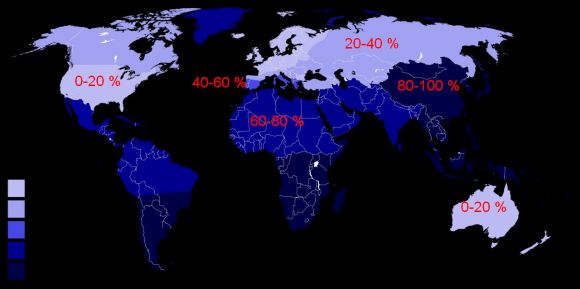
2.3. Don't Cry Over Spilled Milk, p. 21
Dr. Oski illustrates a case where a child suffers from diarrhea, gets pale and obviously has an iron deficiency anemia since the age of 6 months. Only a large medical center finds out after two years that the child has a rare absolute cow's milk protein intolerance. Only once cookies, custard and ready-made meals (convenience food) were taken off this child’s diet, the problems finally disappeared.
Milk allergy
This shows that even these products have milk or milk powders added to them. The previously discussed lactose intolerance affects only certain people and in that case quantity plays a role. In milk allergies discussed here, even the smallest amounts of milk protein create adverse effects.
Although Wikipedia doesn’t seem to distinguish it, lactose intolerance has nothing to do with cow's milk allergy. In lactose intolerance, the person concerned lacks the enzyme lactase (LPH, LCT) for digestion.
Elsewhere under “Got Milk?” Wikipedia shows this milk advertising campaign with the image that is declared public domain.
Dr. Joyce D. Grybowski, then director of the Pediatric Gastrointestinal Clinic at Yale University School of Medicine stated that they see an absolute cow’s milk protein intolerance about once a week. The symptoms for these milk allergy cases are different. See also the book by Joyce D. Grybowski: "Gastrointestinal Problems in the Infant (Major problems in clinical pediatrics)".
By completely eliminating milk proteins, the problem may disappear within two days. After absolute abstinence, these children generally gain at least a minimum tolerance of milk proteins by the time they are two to five years old.
The author takes us back to the subject by showing the uncertainty that exists about milk allergies. Some researchers come up with 0.3% of children and others 25%. Again, this is exclusive of children who are lactose intolerant.
The book "Allergies to Milk" by Prof. Dr. Sami Bahna M.D. (PDF at worldallergy.org) and Dr. Douglas C. Heine M.D., is recommended. It was first published in 1980.
In the US, 15 to 20% of children under the age of two suffer from iron deficiency, approximately half of which are due to intolerance of milk protein. Blood loss in the intestine is not concentrated to one location and is so small that it is not visible in the stool, a stool-examination would need to be done to detect it.
Milk also has too little iron, but that is not the primary problem. By consuming large quantities of milk the iron deficiency may disappear, but you will also suffer from the ill effects.
Iron deficiency
Since baby bottles are made of plastic, you can leave the bottle with the baby without the risk of it getting broken. This leads to “blue bottle syndrome,” i.e. toddlers who walk around with the bottle in their mouth and hand. These “milkaholics” usually suffer from iron deficiency.
This is not only because cow's milk provides too little iron, but also because the body can only metabolize a small percentage of the iron in milk. The child may no longer be hungry, but is irritable, apathetic, inattentive and often cries. The vicious cycle begins by giving him the bottle as a calming agent.
The term “bluebottle syndrome” came about because blue plastic bottles are prevalent, although there are other colors as well. It’s also known as nursing-bottle-syndrome. Under the term nursing-bottle-syndrome, Wikipedia shows what happens to the young child’s teeth.
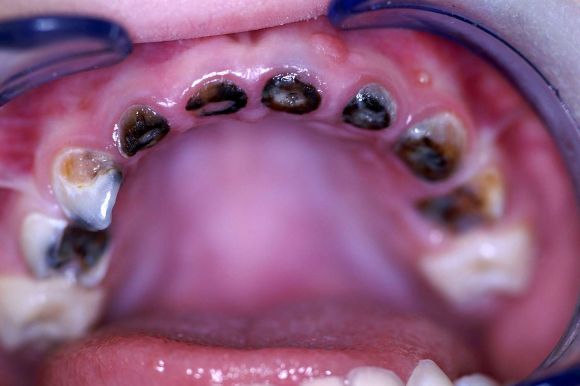
Dr. JW Gerrard and his team in Saskatoon, Canada, monitored 787 babies. The team observed each baby from birth. The mother was given no advice on milk or substitute products, so as not to affect her.
The team recorded from when the babies were given milk replacement including the composition of that milk substitute.
The criterion for milk allergy was the occurrence of (1) nasal congestion, asthma attacks, respiratory infections, bronchitis (chest infections) or (2) efflorescence (skin rash or changes to the skin in different areas) or (3) vomiting or diarrhea, if there was no other explanation for the symptoms.
The sooner cow's milk was used, the more milk allergy occurred
In such cases, the baby was changed to soy products. If the symptoms disappeared, they tried it again with milk-containing baby formula. Only when symptoms reappeared, was the baby declared to be allergic to cow's milk proteins. (p. 25)
They found 59 babies, or 7.5% that had a cow's milk allergy with this method. Further investigation showed that 25% of these babies showed symptoms after the first three days of receipt of baby formula. A further 25% of the babies developed symptoms at least within the first week. Half of the affected babies reacted later.
The team realized that the sooner cow's milk was used, the more milk allergy occurred. In babies that received cow’s milk early, the percentage rose to 25%. The milk allergies often occurred when one parent suffered from hay fever or asthma. (p. 26)
A group of researchers at the University of Colorado and the University of Miami Schools of Medicine showed that:
This affected the children who did not respond to cortisone treatments. Without this information, such children may die prematurely.
Dr. J. Dan Baggett, a pediatrician in Alabama, said that he discovered the relationship between early cow's milk consumption by infants and skin problems and that some of the children later suffered from asthma if they were not taken off dairy products. He then introduced a diet without milk, wheat, eggs and lemons. But he also saw that some children reacted to soy with allergies.
Even early rheumatoid arthritis was curable with complete elimination of dairy products. (p. 28) The diet consisted of special breads, crackers, cake (cake mixes) and cookies without ingredients such as casein, caseinate (denatured casein), whey or milk powder. Corn oil and safflower oil were recommended for cooking. Perhaps they also paid attention to having ingredients be gluten-free.
Conversely, children with pharyngitis (sore throat), streptococcal pharyngitis or more precisely pyoderma gangrenosum (ulcerative dermatitis) had ingested milk protein within five days before the first symptoms. (p. 29)
Besides that, he only had to send 12-14 patients to a hospital instead of 100 and the length of stay declined from an average of five days to three days.
"Breastfeed is best fed"
His motto is: Breastfed is best fed and cow's milk is the ideal food for the newly born and rapidly growing calf.
Dr. Baggett recommended for pregnant women to eat eggs (if tolerant) and dark green leafy vegetables and take several tablets of calcium. He strongly recommends to refrain from any type of milk protein and to avoid chocolate, colas, peanuts and raw onions as much as possible.

With a good selection of plant-based foods you don’t need calcium tablets; you do need vitamin B12, however.
Moreover, I'd like to make a remark on the quote above. Without calves, there will be no milk from the cows and the calves get slaughtered before they reach eight months...
In it the authors write that up to that time there were various opinions of researchers circulating, but it should have been clear since 1980 how harmful milk can be.
Because parents are so affected by the dairy industry they find it absurd to renounce “the good milk,” doctors probably don’t dare to offer an alternative. For most mothers, cow’s milk is the best thing you can give a toddler.
In 1964 Dr. Baggett learned from Dr. William Deamer from San Francisco, that even the so-called growing pains (musculoskeletal pain) could be prevented by abstaining from milk and dairy products.
The link between "growthhormones" in cow’s milk and growing pains
But neither the doctors nor Wikipedia grasped the link between "growthhormones" in cow’s milk and growing pains. Actually, this would simply be a logical prediction of the effects that the multiple "growthhormones" in cow’s milk must have on a human baby as compared to a calf.
It is also logical that these "growthhormones" are only meant for the lactating time period and may promote cancer at an older age. In addition to that, there are scientific studies on it. I call them the accelerators that patients use, while their cancer doctors are trying to put on the brakes at the same time, for example, with cytostatics used as cell division inhibitors. It’s alarming that such logical relationships cannot be incorporated into practice.
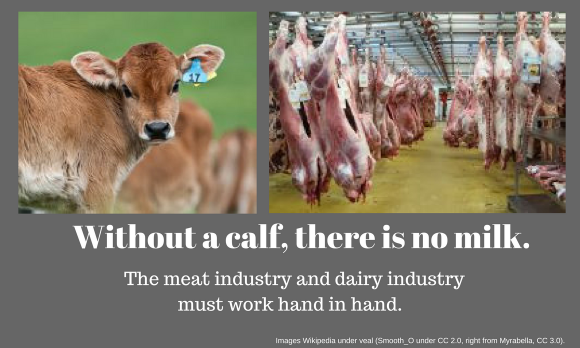
Few readers know that cows get milk only after giving birth to a calf and that the calves go to the slaughter house after just a few weeks.
2.4. Can Fat Be Fatal?, p. 33
The American Heart Association (AHA) highly recommends limiting the consumption of milk and dairy products at any age and with good reason. One million Americans die each year of cardiovascular disease. This is about half of the causes of death in the United States. 15 to 20 % die from it before the normal retirement age.
Most of these deaths could be avoided by elimination or strong reduction of milk and dairy products
It would be alarming if most of these deaths could be avoided by elimination or strong reduction of milk and dairy products.
But Wikipedia says for example this, In human medicine, usually all congenital diseases of the heart, blood vessels, and circulatory system, which are not caused by injury, are considered cardiovascular disease.
You read that there correctly “congenital!”
At the very bottom it says, Occasionally, the term cardiovascular disease is associated only with atherosclerosis and disease of the heart and blood vessels caused by the risk factors diabetes mellitus, smoking, lack of exercise, genetic predisposition, etc., as observed in the MONICA study conducted by the WHO since the 1980s.
and that’s called “evidence based medicine," EBM . The term “industry-evidence based medicine,” would be suitable.
Eating habits are excluded!
Around the year 1900, life expectancy of a newborn was about 50 years, in 1977, it was 72 years. The biggest factor in this increase is the extremely strong reduction of child mortality due to the successful fight against viruses and bacteria and improved hygiene and infant nutrition.
Dr. Oski explains the processes that lead to atherosclerosis, step by step and shows the effects. Most affected are ultimately the brain, the kidneys, the legs and the heart. Best known are the effects of myocardial infarction (heart attack, AMI) and stroke, both originating from artherosclerosis.
Artherosclerosis can begin as early as two or three years of age
Until the 1950s, doctors thought that atherosclerosis was a normal sign of aging. Only the autopsies on soldiers killed in the Korean War with an average age of about 20 years, revealed that about 80% of the dead had the beginnings of atherosclerosis.
Follow-up studies have shown that the process can begin as early as two or three years of age. (p. 35)
The plaque, mostly made of cholesterol, gets created in a slow process that can take 20 to 40 years. The majority of Americans have signs of severe arteriosclerosis by the time they are 50.
Risk factors were high cholesterol levels (also blood cholesterol) (1), poor relationship between HDL (high density lipoprotein), which should have a high proportion, and the “bad” LDL (low density lipoprotein) in serum (2), arterial hypertension (3), diabetes mellitus (4), tobacco smoking (5), physical inactivity (6) certain personality traits (7) and family history regarding heart attack and stroke (8).

Simply put, you just need to remember that the lipoprotein HDL causes the removal of cholesterol from cells and it’s levels should be high, since in principle it acts anti-atherogenic (not artherogen). See cholesterylester transfer protein (CETP). LDL (actually “small, dense LDL”), however, promotes atherosclerosis.
Wikipedia: “Artherosclerosis (‘hardening of the arteries’) refers to the physiological aging process of an artery, while the term atherosclerosis emphasizes the formation of a pathological atheroma which may cause a stenosis.” Foam cells are an early form of damage.
These factors were established by the Framingham Heart Study conducted by the National Institute of Health in Framingham, Mass. In 1949, 5'000 healthy men and women aged 30-59 were thoroughly examined. The region had been chosen because it represents the average US life.
The test persons got in-depth physical examinations every other year. After 1'000 of those people had died, risk factors became clear. High blood cholesterol levels stood out from the other risks and especially with genetic predisposition in the family.
Blood cholesterol is produced in the liver, the digestive organs and by one’s diet. It was recognized that animal products such as eggs, dairy and meat increased the levels.
Saturated fats, i.e. those which are not liquid at room temperature, cause it. They are contained in butter, cheese, cream, meat, and also in chocolate and pre-packaged food products such as pizza. (p. 36)
Unsaturated fats for example, corn oil, cottonseed oil, safflower oil and other vegetable oils can decrease cholesterol levels.
Actually, these connections have been known about since before the 1920s. The Russian scientist, Prof. Dr. Nikolai Anitschov M.D., found out about it in his experiments on rabbits. Nikolay Nikolaevich Anichkov (1885-1964) was a prominent pathologist. See Anitschkow cell.
Later more animal testing was conducted, which confirmed his results. But only the "Framingham Study" showed clear evidence on humans. It showed that people with 240 mg of cholesterol in the blood had a three times higher risk of heart attack than those having 200 mg or less.
Studies in many countries confirmed these observations later.
A study from Finland, conducted from 1959 to 1965, showed that by using skim milk instead of milk, mixed with soybean oil (soybean oil) and “soft” margarine as butter, lowered cholesterol by levels of up to 20 % in the blood. Thus, the death rate due to cardiovascular events decreased in men by more than half. (p. 38)
Prof. Dr. Frank A. OSKI M.D. provides more examples of how up to 29 % of the death rate from heart attack was preventable by dietary changes.
Congenital disorders of lipid transport, which cause great susceptibility to coronary heart disease, exist.
Hyperlipoproteinemia
He gives as an example primary hyperlipoproteinemia (HLP, hyperlipidemia), an inherited disease that occurs at least in one half percent of the population.
But the study of a pathologist on more than 1'500 children who died from accidents, showed the direct relationship between children who were given breast milk and children given bottles with cow's milk.
In nature no other mammal drinks the milk of another species or even drinks milk after a weight gain of around three times their birth weight. At the same time it has been found that no other mammalian species suffers from atherosclerosis.
Eating Less May Be The Key to Living Beyond 100 Years
In February 1977, the United States Senate Select Committee on Nutrition and Human Needs published as part of the "Dietary Goals for the United States" the recommendation to consume less fat and dairy products. Numerous organizations including the National Dairy Council, disagreed with this conclusion.
In 1982, the National Research Council published a report entitled "Diet, Nutrition and Cancer", which had at least some effect. The message was that eating habits have a significant impact on the development of cancer.
However, the report fell too short with the recommendation that the daily fat intake of Americans should be 30 % instead of 40 % on average. (p. 40) This was especially evident in its link to colorectal cancer, breast cancer and prostate cancer, not to mention the cardiovascular diseases that the author first discussed.
On June 8, 1982, an article was published in The New York Times, by Jane Brody entitled "Eating Less May Be The Key to Living Beyond 100 Years". However, this finding is based on animal studies. She suggested reducing the calorie intake that led to the existing normal weight by one third and to maintain healthy food choices. Reduce your fat intake and reduce your caloric intake – you may find yourself eating for a much longer time than you thought possible.

Unfortunately however, this statement falls short because less fat wouldn’t be the reason for a shorter life in good health. It is much more so the type of fat and the excessive amount of animal protein.
2.5. Alternatives—Two Sides To The Story, p. 43
Alternatives to milk and dairy products are different depending on age. The author humorously states that in infants, it should be the left and right breast of a healthy mother.
From about the mid-1960s, milk substitutes have been worked on and now have the composition of breast milk. One should choose formulas that do not contain cow's milk ingredients.
Breast milk and the importance of antibodies

In my view, we should not rely on soy compositions, but others. Also, I don’t entirely agree that these compositions can truly replace breast milk. Breast milk changes too much depending on the age of the infant and probably also depending on the mother's genetic disposition.
However, mothers should know that most substances they eat will appear in their breast milk. Dairy products are thus taboo.
Dr. Oski mentions another important factor of breast milk, in particular antibodies against infections, etc. They are particularly important in the first few days and are in the usually somewhat yellowish milk called colostrum. Antibodies (immunoglobulins, earlier also gamma-globulins) in breast milk are genetically matched.
The importance of antibodies is known at least since the 1930s by a study in Chicago with more than 20'000 infants. A point though is that antibiotics were not yet know at that time. Milk does not have antibiotics anyhow, but actual antibodies. (p. 44)
The author describes the comparison between the two subjects in detail.
There were three groups as follows, infants that were breastfed for nine months or longer, the second group were babies that were breastfed for a shorter time with subsequent replacement milk and the third group was given only diluted and boiled cow's milk with added sugar. All three groups were given orange juice after a month and cod liver oil after the first six weeks. At five months cereals were added and at six months vegetables.
It was quite noteworthy that the death rates from respiratory infections were 120 times higher than in breastfed babies. An earlier study in eight locations in the United States accompanied the babies only for six months. The difference in deaths was one to twenty.
Because we know of the efficacy of antibiotics today, the comparison would have been completely different today. For example, the difference in Chile is only twice as high instead of 56 times the amount, and on an entirely different level. Amazingly, breastfed children who were additionally fed or given cow's milk early, end up with results almost equally bad as those fed with cow’s milk only.
Since the richer families in Chile departed from breast milk, their children showed higher death rates than children of the poor population. A study in Guatemala via stool samples showed that children fed only breast milk showed no pathogenic germs or suffering from gastroenteritis (gastrointestinal inflammation), but in children on alternative diets, gastroenteritis was always an issue. They had only considered areas with poor hygiene and primitive sanitation.
Once you wean an infant, the intestinal flora (fecal flora, intestinal flora, med. intestinal microbiota or gut microorganisms community) and escherichia coli (coliform bacteria) show up. With changed resistance in the baby, these bacteria can spread, enter the nervous system, the lungs, the kidneys and the blood.
There used to be gastroenteritis outbreaks in pediatric wards of hospitals, which could only be combated with a diet of breast milk. In Belgrade, they found out that if breast milk is boiled, it loses these protective factors. (p. 46)
Especially in emerging markets and developing countries, food manufacturers try to convince mothers that bottle milk is better than breast milk while the opposite is true.

In Chile for example, the percentage of breastfed children dropped from 95% to 6% within 20 years. And yet children able to receive breast milk for at least a year have better defenses against infections for the rest of their lives. As with the other mammals, the infant will have increased to about three times their birth weight at that point.
Baby Formula Abroad: Exporting Infant Malnutrition
Leah Marguiles (actually Leah Margulies) wrote the article "Baby Formula Abroad: Exporting Infant Malnutrition" for the 10 November 1975 edition of Christianity and Crisis.
It explains how the food industry is fighting for market shares in this unsaturated market. Milk counselors that infiltrate hospitals and clinics are used for example as “mother craft personnel” to convince the population.
Thus, about 90% of mothers in Jamaica started feeding their infants formula-diet at the age of six months in good faith.
Result in Chile:
In 1973 three times as many deaths occurred among infants who were bottle fed before three months of age than among wholly breastfed infants. (p. 49).
Part of the problem was the difficulty to dissolve these powdered formulas sterile and in the right proportion.
In 1973 a Third World organization wrote Nestlé Kills Babies and was promptly sued by Nestlé. In England Mike Muller wrote the book "The Baby Killer", in which he reported on these bad practices. How unconcerned the food industry dealt with these problems was described in the Consumers Union in the U.S. in an article entitled "Hungry for Profits".
Leah Margulies: "The International Code of Marketing of Breastmilk Substitutes": A model for assuring children's nutrition rights under the law was first published in "The International Journal of Children's Rights", Vol 5, No 4, 1997, Kluwer Law International Publishers, The Hague, The Netherlands, pages 419-438.
See also this PDF concerning the Nestlé boycott in 1977-1984.
Wikipedia gives a detailed account of the Nestlé boycott, but without the history in Switzerland with Moritz Leuenberger, who later became part of the Federal Council, as a defender of the Third World Working Group Bern.
In Kenya, the cost of breast milk substitutes is estimated to be eleven and a half million dollars a year which in this troubled country is two-thirds of health expenditure or 20 % of all funds of the development help.
The World Health Organization (WHO, World Health Organization) issued a ban on the advertising of breast milk substitutes and recommended breastfeeding with breast milk in 1981. In 1971 only 25 % of mothers breastfed their babies in the United States, but in the mid-1990s, the proportion rose to 58 %.
In 1971, 68 % of children in the United States received cow's milk products at the age of six months, but by 1981 it decreased at least to 17 %. This was achieved as a combined effort by the American Academy of Pediatrics (1), American Pediatric Society (2), Pediatric Research Society (3) and Pediatric Ambulatory Association (4). It went so far that even the National Dairy Council openly admitted that cow's milk is not suitable for children under six months. More figures are provided in Chapter 11.
Dr. Oski closes the chapter by saying:
The infant should never receive cow's milk in unmodified form. After the first year of life, the child requires no milk of any type. The child, like us adults, can thrive without cow's milk ever crossing his lips.(p. 52)
2.6. The Calcium Scare, p. 53
The dairy industry has successfully implanted the idea that we need a high amount of calcium for healthy and strong bones and teeth and that this is best covered with milk and dairy products. In fact, milk contains a lot of calcium, about as much as certain vegetables. But the body can use only a small portion of the milk calcium if any at all as opposed to vegetables.
A cup of boiled cabbage (brassica) or turnip or 120 g flour, supply more than 250 mg of calcium. Beans, broccoli, almonds or fish are other good sources of calcium.
In the book "NO MILK", Dr. Daniel A. Twogood writes on page 72:
Drinking milk for calcium makes about as much sense as smoking for weight control.
Factors that influence whether the calcium gets absorbed
The WHO recommends an intake of 400 to 500 mg of calcium per day. In the UK and Canada 500 mg are recommended and the Food and Nutrition Board of the National Academy of Sciences in the U.S. even recommends 800 mg.
Actually such statements mean little because there are several factors that influence whether the calcium gets absorbed into the body’s reserves at all and if so, how much. Phosphate content, dietary fiber and protein consumed as part of food are key factors. Vitamin D (cholecalciferol, vitamin D3) and the hormones are also needed. (p. 54)
An important reason for this is that cow's milk contains a lot of phosphorus, and phosphorus and calcium create an indigestible compound which then has to be excreted through the kidneys.
Both, too much or too little calcium harms the body. Other nations, some of which consume only a fraction of calcium of what Caucasians (Europeans, fair-skinned people) consume, mainly from plants, have strong bones and osteoporosis is a rare occurrence.
Dr. Alexander Walker of the South African Institute for Medical Research even stated, There is no firm evidence that calcium deficiency exists in humans.
(p. 55)
The fact is that the Americans on average consume 807 mg of calcium through milk alone and they have a high incidence of osteoporosis, while the people in Spain take 308 mg, Brazilians 250 mg, Taiwanese 13 mg and the people of Ghana on average 8 mg!
2.7. Do You Really Want a Résumé of the Cow's Lunch?, p. 57
In this chapter, the author discusses the quality of milk. He mentioned a publication in the Consumers Union of January 1974 entitled "Milk: Why Is the Quality So Low?" This resulted from an intensive study conducted in five US states.
Heating with the temperature to high or duration too long causes this flavor. The taste can vary up to being soapy.
Milk always has an amount of undesirable bacteria
Milk always has an amount of undesirable bacteria. Warm milk is the best breeding ground for the proliferation of bacteria. Reheating for a baby bottle is especially unwise. Heating, such as pasteurization, reduces the number of coli- and tuberculosis-bacteria, but the remaining bacteria multiply rapidly.
After pasteurization, only 20-thousand bacteria per milliliter are supposed to be present and only a maximum of ten coli bacteria. That number doubles in the refrigerator within 35 to 40 hours.
Only 4 of 25 samples were free of pesticides. All others showed hydrochlorofluorocarbons. It is a known fact that such organochlorine compounds accumulate in the body and can lead to genetic defects and cancer. The Food and Drug Administration (FDA) suggests that a small amount of substances that cause cancer are not a problem...
The samples showed little aflatoxins and antibiotics although antibiotics are often injected to handle mastitis. But farmers may not use the milk for the first 48 hours after the injection and this is usually observed at least in the U.S. People susceptible to penicillinum might otherwise get hives, asthma or unexplained rashes. (p. 61)

Dr. Oski does not mention that about 1 in 7'000 people has an anaphylaxis and thus may suffer circulatory shock with organ failure and even fatal circulatory failure, in other words anaphylactic shock (anaphylaxis).
The hormone progesterone causes another problem. It comes from pregnant cows. Dr. Jerome Fisher Kearney (M.D., Sc.D. Med.) points out that today’s milk (at least in the U.S.) comes from up to 80 % of cows that are pregnant and writes the following,
Progesterone in milk can cause acne (acne vulgaris) in adults, which disappears after some time when milk is eliminated. Dr. Fisher realized that children with acne usually drank milk excessively. He showed that the acne disappeared or at least greatly improved after the children or teens stopped milk consumption on his advice. However, most dermatologists (dermatology) do not take this fact into consideration.
Acne vulgaris and seborrheic dermatitis
The study conducted by Dr. Jerome Fisher included 1088 cases of acne vulgaris. He had 721 female and 367 male test patients for this study, most likely because fewer men would see a physician for such problems. He lists out over 50 scientific studies designed to detect the cause of acne and describes them briefly. He also references 132 books.
Fisher shows that acne vulgaris and seborrheic dermatitis (seborrhea) have similar causes. He noticed that most acne patients consume between 50 to 300 % more milk than the average population. He noted that this secondary point was not a factor in only 4.5% of acne patients because they did not drink milk. See link to the Fisher's study here.
2.8. “Beware of the Cow,” p. 65
Dr. Oski first summarizes the important points:
Diarrhea and cramps, gastrointestinal bleeding, iron deficiency anemia, skin rashes, arteriosklerosis, and acne – these are disorders that have been linked to the drinking of whole cow's milk. So have recurrent ear infections and bronchitis. Can there be more? Yes. Leukemia, multiple sclerosis, rheumatoid arthritis, and simple dental decay have also been proposed as candidates.
The author emphasizes that the problems described so far are well supported and accepted and he only discusses disturbing theories below.
Beware of the Cow
He quotes at the beginning the first sentence from an editorial in the best English scientific journal The Lancet, entitled "Beware of the Cow": Along with the evidence that beef-eating may be connected, in adults, with large-bowel cancer comes news of a possible fresh menace from cows, this time in the young.
Previously this disease was not known to exist in chimpanzees. However, the milk used was from cows bearing the C-type cow virus that naturally occurs in cows. The monkey babies developed leukemia in the 34th and 35th week and died after six weeks of illness.
It is known that most infectious diseases which chimpanzees can contract, can also be transmitted to humans. A report in the scientific journal "Science", written by Dr. Farrar, Dr. Kenyon and Dr. Gupta of the University of Pennsylvania School of Veterinary Medicine shows results of experiments and concludes:
While earlier epidemiological surveys showed no association between human and bovine leukemia, the most recent survey, involving many cases, showed a statistically significant increase in human acute lymphoid leukemia in areas with a high incidence of bovine leukemia and bovine leukemia virus infection.
Multiple sclerosis (MS) has a different geographical distribution, and there are various theories about that, but only the two scientists Dr. Bernard Agranoff and David Goldberg of the University of Michigan looked into nutritional reasons in 1974.
They studied 26'000 deaths due to MS in the United States. They found that the states of Alabama, Georgia and Tennessee had only half the amount of incidence. They examined several factors such as education, financial situation, number of doctors, hospitals, and beds, but in the end they found a clear connection with milk consumption.
Multiple sclerosis and milk consumption
After that, they researched 21 other countries to see whether the same conditions held true there too. Once again they found a definite link to milk consumption.
The reasons why milk could be so harmful were, however, not recognized until 1996. It was only known that the nerves especially need fat and probably the milk fat which is unknown to the body, may be the cause. Their conclusion was, Cow's milk may be an unfortunate substitute for human milk in infancy or a risky food source thereafter, or both.
(p. 68)
Dr. Oski further states that it was probably more than a coincidence that another research group found another not well-understood neurological disease, amyotrophic lateral sclerosis linked to milk consumption. Because of the well-known athlete who died of it, it’s also known as Lou Gehrig's disease in the U.S. (Charcot disease).
Besides heavy metals such as lead and mercury, and more physical activity, higher milk consumption as compared to the control group was shown as a possible cause.
The group of neurologists at Baylor College of Medicine in Houston, Texas, only examined 25 people with this rare but deadly disease. However, they compared these with 25 healthy people who had similar backgrounds and situations. The original text reads as follows:
The neurologists analyzed many variables in 25 patients with this disease and compared the patients’ histories with 25 healthy individuals of similar sex, age, racial background, economic status, and education. The factors that set apart the patients with amyotrophic lateral sclerosis from their normal counterparts was that the patients reported an increased incidence of exposure to lead and mercury, more participation in sports, and higher ingestion of cow’s milk — this gives us more food for thought.
Juvenile rheumatoid arthritis and milk consumption
In regard to young people, the author mentions again pediatrician Dr. J. Dan Baggett M.D., who found a link between Juvenile idiopathic arthritis (JIA, juvenile rheumatoid arthritis) and milk consumption.
He had many patients in his practice that were sometimes in a rather worrisome state, but he could heal them by eliminating all types of dairy products.
Various other pediatricians had similar successes. But these successes were rarely given attention by other doctors.
Anti-social behavior and milk consumption
Scientist Dr. Alexander Schauss M.D. from Tacoma, Washington and his staff (AIBMR) found an association between heavy milk consumption and anti-social behavior.
A study of young criminals showed that they copnsumed ten times more milk and dairy products than other comparable people. They ate less nuts, fruits and vegetables. Dr. Schauss suspected a kind of protein poisoning, but the milk fats may also have been a factor.
The destruction of teeth and milk consumption
Dr. Frances Castano, a researcher for dental health at the University of Pennsylvania showed that milk also plays a part in the destruction of teeth. This can happen if you give a milk bottle to children as a sleep aid. After the infant stops swallowing during sleep, the remaining milk in the mouth forms an ideal breeding ground for bacteria that attack teeth.
Especially after the first twelve months it can wreak havoc and parents wonder why their child then develop such bad teeth.
Dr. Castano recommends breast milk and if one wants to give a bottle, to fill it only with pure water.
2.9. “Milk has Something for Everybody,” p. 73
Milk marketing suggests: Milk Drinkers Make Better Lovers
or Everybody Needs Milk
or Milk: Drink It for All It's Worth
or There Is a New You Coming Every Day – Drink Milk
and Milk – The Perfect Food.
Yet when in April 1974 a headline of The New York Times read, Federal Trade Commission Finds Milk Advertising Campaign Deceptive,
the public doesn’t read it or doesn’t believe it, writes Dr. Oski.
Certain milk campaigns are false, misleading and deceptive
In fact, the Federal Trade Commission (FTC) filed suit, alleging that certain milk campaigns are false, misleading and deceptive. The FTC could no longer shut their eyes and had to act because of the mounting scientific evidence to the astonishment of the dairy industry.
The dairy industry was using sports idols and celebrities like Mark Spitz, Vida Blue, Ray Bolger, Abigail Van Buren (actually Pauline Esther Phillips) and Florence Henderson to promote (propaganda) that everyone needed milk.
The dairy industry merely changed the campaign to the slogan Milk Has Something for Everybody,
which after all can’t really be denied, even if “that something” is a substance that makes you sick. (p. 74)
Farmers alone pay five million dollars for milk advertisement a year. Traditionally, the government institutions have been closely allied with the dairy industry and issued common promotional materials for the consumption of milk and dairy products, such as the brochure "Milk in Family Meals", which was issued by the US Department of Agriculture.
The author shows other efforts to promote milk that the taxpayer paid for. This all-encompassing marketing made it sound almost un-American if someone in the United States objected to milk or questioned it. The huge dairy industries and food industries keep an eye on any publication, both in terms of positive or negative comments in any kind of public media.

Such services used to be called press clipping office, press service or information service. Today these services are extended to electronic media and are called media monitoring as part of public relations (PR).
The service gets every magazine, newspaper and other publication evaluated and then copies from it certain articles containing specific target words and sends them to the client.
The result of media monitoring are press reviews. Documentation facilities collect and document newspaper articles in full according to subscribed keywords.
Companies use this to adjust and improve their product offerings. Press services may include for example, brands, products, prices or political statements.
Therefore, Dr. Oski of course got a letter from the National Dairy Council (NDC) in Chicago, which condemned his statements. Not only that, but the NDC published a letter in which they condemn his publication in the media and positions the industry in the best light with a longer article citing all the alleged benefits of milk. Thus, any publication about the disadvantages of milk gets transformed into a victory for the dairy industry in the end and at the same time intimidates the media.

The earliest clipping service and media observer originated in 1879 in Paris as the L'Argus de la Presse office.
Such media monitoring services are especially used by businesses, associations, political parties, governments, institutions, cultural institutions, tourism companies and related organizations.
In Switzerland, for example, ARGUS der Presse AG, which was founded in 1896, employs 160 people. Services include for example, media monitoring, media analysis, information management, clipping, and press reviews.
Information search and sharing of information as such should not be condemned. What happens with that information can however, be a problem.
Dr. Ellen Mckenzie M.D., a pediatrician and psychiatrist took up the thread and published the article "Psychologic Factors in Milk Anemia". Dr. Oski quoted her statement, Everybody needs milk’ carols a current commercial from television and billboards. Cow's milk, a liquid protein food well suited to a calf before its teeth erupt, has been so touted as ‘nature's most nearly perfect food’ that even some doctors consider it an adequate substitute for a varied diet.
The mystique of whole, homogenized, pasteurized, bottled milk (the most germ-laden, allergenic, and expensive of available formulas) is enormously powerful. Families will resume giving it despite their own experience or the doctor's warning of allergy, respiratory disease, or anemia. Mammon always intrudes: the director of a local television program was not allowed to mention milk anemia on his program because the dairy companies were big advertisers. (p. 77)
2.10. Milk and Tension-Fatigue Syndrome, p. 79
The pediatrician Dr. William G. Crook, Pediatric Clinics of North America published an article in February 1975 entitled "Food Allergy – the Great Masquerader". In it, he explains that food allergies (and drugs or medication) besides causing the classic symptoms such as skin rashes, respiratory disease or gastrointestinal problems, can also cause personality changes, fatigue and attention disorders as they occurred in his study of 4'000 children. Dr. Crook referred mainly to milk, corn and sugar from sugar cane as potential causes.
Food allergies and hay fever, bed wetting, stuffy nose, insomnia, anxiety and hyperactivity
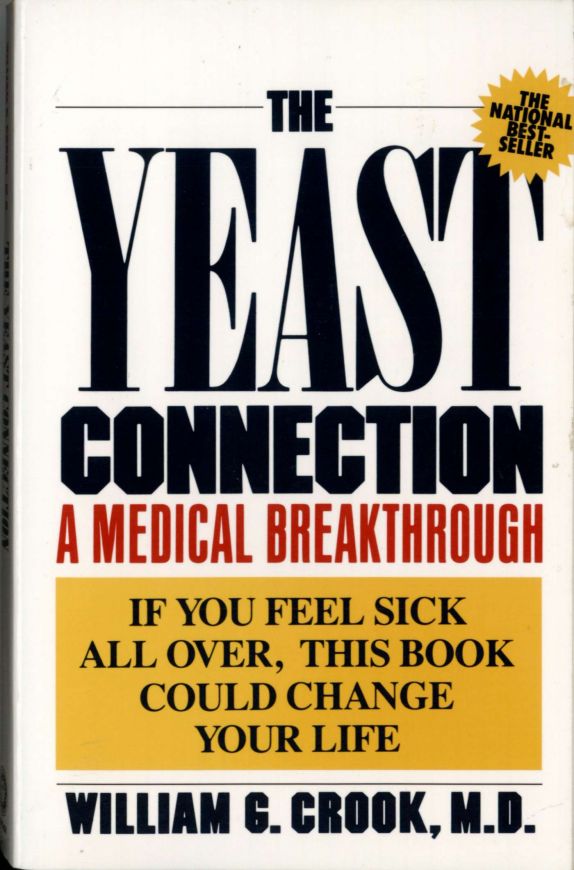 | Another book by Dr. William G. Crook, "The Yeast Connection: A Medical Breakthrough" and with the subtitle: If you feel sick all over, this book could change your life. can help in cases of persistent fatigue, if yeast is a factor. Dr. Crook recommends, no sugar, no dairy, no yeast, no wheat, writes one reader who regained his health. |
In 1873 the physician Charles Harrison Blackley described pollen allergies, for example, allergic rhinitis (hay fever), which have similar effects. However, it must be carefully established whether other causes can be found for the symptoms mentioned, such as infection or anemia or chronic diseases. However, in the vast majority of sufferers, a food allergy is the cause.
Even bedwetting (enuresis) could be traced back now and then to a food allergy.
Stuffy nose is a common symptom of milk allergy in particular, but also constantly tired children or the opposite, children who are constantly active, making faces, spinning around, bouncing and never sitting still.
Dr. HL Newbold M.D., psychiatrist, found that food allergies caused insomnia (a sleep disorder) in adults and anxiety disorders (anxiety) or even depression. Both in children and adults, the cause was mostly regularly cow's milk.
Dr. William G. Crook M.D. found a food allergy to be the cause in 41 of 45 children with hyperactivity or learning disabilities. The problems disappeared completely or to a large extent as soon as the food causing them was eliminated completely off the child’s diet.
Antibodies (immunoglobulin) in the blood generally indicate merely that you are eating more of a particular food. Only, with the symptoms disappeared and then if after that consuming that particular food again causes the same symptoms.
Conclusive evidence for an allergy would be only if the particular food is eliminated completely for three weeks with resultant remission of symptoms, and if after that consuming the particular food once again causes the same symptoms to reappear.
Incidentally, the defense against foreign substances in the body is carried out by the antibodies binding to the antigens. This is an essential part of our ability to fight foreign substances or diseases.
It takes one to three weeks until the symptoms disappear if it is a food allergy. Reintroduction of the particular food should also show the symptoms again. Only then can you determine with certainty that it is a food allergy. Dr. Crook and Dr. Oski recommend first examining as the first possible cause.
2.11. “What to Do instead?” p. 83
Dr. Oski quotes Chief Justice Oliver Wendell Homes, Jr. with the following words: A pair substantial mammary glands has the advantage over the two hemispheres of the most learned professor's brain in the art of compounding a nutritious fluid for infants.
But what should be done, asks Dr. Oski, when a woman cannot give her baby her own breast milk or does not want to? Or what can be given to children or adults instead of milk?
The risk for an allergy is greatly diminished with these products. He mentions three brands: Similac, Enfamil and SMA.
Sensitive children can be given products in which the milk protein is already separated into amino acids. Good products also contain the necessary amount of iron as opposed to cow's milk. The amount of vitamins is also generally correct. Most child nutrition specialists see it as an error that infants are given skim milk because fat is very important in infancy.
Procedure for feeding infants
Dr. Oski quoted the well-known expert on infant nutrition, Dr. Samuel J. Fomon: When attempts are made to control weight during infancy, it is recommended that modest rather than drastic reduction in calorie intake be employed. The diet should provide 7 to 16 percent of calories from protein and 35 to 55 percent of calories from fat. These dietary stipulations can be met with ease when human milk or whole cow milk (or infant formulas) serves as a major source of calories but are nearly impossible to meet when skim milk is fed.
(p. 85)
Then Dr. Oski recommends, as a pediatrician, the following procedure for feeding infants:
From the age of five to six months some solid food should be introduced slowly. That is best done with fruit and some cereal.
Vegetables can be added between six to nine months.
He also mentions meat, which is unnecessary, however, when one ensures that the child gets enough vitamin B12. Pregnant women by the way have to observe that too.
If you want to introduce eggs, then you should wait at least until the age of nine months to one year.
After the first year of life, milk is no longer necessary but breastfeeding can continue. F
ruit juices can also provide needed fluids and they are also a source of calories from carbohydrates. The author believes that with a 1-year-old toddler, the milk bottle should be reduced slowly until no milk of any kind is given at 18 months.
After that, the author addresses adult humans. He shows what Americans drink on average based on statistics from 1975. It was 56.7 gallons of water followed by 39.6 gallons of soft drinks, 27.8 gallons of coffee, 24.8 gallons of beer, 21.6 gallons of milk, 7.4 gallons of tea, 6.1 gallons of fruit juices, 2.0 gallons of spirits (liquor) and 1.7 gallons of wine.
He believed that more water should be consumed as well as fruit juices.
Grade A pasteurized milk, skim milk, powdered milk and condensed milk
Furthermore, he saw the problem mainly in so-called “Grade A pasteurized milk.” That is milk with a fat content of at least 3.25% plus a minimum of 8.25% other solid ingredients. This milk can be sold across the borders of the states in the U.S. Other pasteurized milk is specified per state.
People who don’t suffer from milk and still want to drink milk should choose skim milk with less than 0.5% fat content because it would at least cause less problems.
Next the author takes up powdered milk, which again liquefied, would cost only a third of comparable liquid milk in the U.S. It is supposed to be kept in the fridge for 24 hours to improve the taste.
He then describes other types of milk in the United States, for example, evaporated milk or condensed milk etc., and explains them in detail. There is also so-called “filled milk,” milk, in which the fat was replaced with vegetable fat.
A farmer and manufacturer of such milk, Charles Hauser of Milnot Company, fought legislation which mandated that filled milk could not be sold in other U.S. states. He saw this as a declaration of inferiority. He finally won the case. The national authority and the dairy industry had to give in.
Dr. Oski also discusses yogurt and points out that it should be made if possible from skim milk. By lactic fermentation, almost all lactose has been broken down into the simple sugars glucose and galactose by bacteria. Thus yogurt is edible by lactose intolerant people.

However, Maria Rollinger, "Milk Better Not!" (Book Review) has a different view in her book because the present processing has nothing to do with traditional yogurt or kefir production. Dr. Oski probably does not know these production processes, but this was Ms. Rollinger’s profession.
The author also addresses an imitation milk containing mostly sodium caseinate (p. 89) and vegetable fat (vegetable oil), as well as dextrose or corn syrup, artificial flavors, and emulsifiers. Sodium caseinate can be digested differently than the calcium casein of milk, which clumps. Coffee creams are often milk imitations.
Imitation milk
Dr. Oski explained that in 1945 Sir Robert E. Rich Sr., later head of the Rich Products Corporation, invented and introduced this artificial milk. Milk imitations are usually produced from soybeans. Meanwhile, imitations of milk are also being made from a large number of other products such as oats, almonds, hemp, flax.
The dairy industry began to acknowledge that cow's milk is not exactly the ideal product. Their first answer was skim milk, to address the problem of too much fat. Later, they tried to change the lactose or add enzymes, obtained from baker's yeast... (See also the book mentioned in the box above by Dr. William G. Crook.)
A cheese producer (cheese maker) from Wyoming, Roy Brog, spent 20 years and numerous experiments to develop a drink made from whey, with the right taste and above all without milk fat, as well as 40 % less lactose, thereby producing fewer allergies than milk.
Mammalian milk comprises two types of protein: whey and curds. Whey contains lactoferrin (lactotransferrin), alpha-lactoglobulin, beta-lactoglobulin, albumin, lysozyme (muramidase), and immunoglobulins (antibodies, e.g. immunoglobulin G). With enzymatic or acidizing processes the curd portion can be removed. If one removes the casein from skim milk, whey remains. See whey protein.
Moreover, the proteins are also different. But with this whey drink, you can at least avoid numerous unwanted saturated fats.
IN 1971, about 68 % of children aged five to six months either drank cow's milk or evaporated cow's milk. By 1981, this figure fell to 17 %.
Dr. Oski’s final words read:
Cow's milk has no valid claim as the perfect food. As nutrition, it produces allergies in infants, diarrhea and cramps in older children and adults, and may be a factor in the development of heart attacks and strokes.
Perhaps when the public is educated as to the hazards of milk only calves will be left to drink the real thing. Only the calves should drink the real thing.
Research Appendix, p. 95
On the following pages, Prof. Dr. FRANK ARAM OSKI M.D. introduces 32 scientific papers he used, describing each on about one page. He used the PaperChase Records of the Beth Israel Hospital in Boston for this purpose and mentioned that MEDLINE is indexed and abstracted by the National Institutes of Health, US National Library of Medicine.

Because of a merger that happened in 1996 with the New England Deaconess Hospital, the Beth Israel Hospital is now called the Beth Israel Deaconess Medical Center (BIDMC).
Scientific Works
- Beer AE, Billingham RE “Immunologic benefits and hazards of milk in maternal-perinatal relationship.” Ann Intern Med (1975 Dec) 83(6):865-71 (Annals of Internal Medicine). Abstract (summary) at PubMed.
- Burr ML “Does infant feeding affect the risk of allergy?” Arch Dis Child (1983 Jul) 58(7):561-5 (Archives of Disease in Childhood). Abstract at PubMed.
- Minford AM, MacDonald, Littlewood JM “Food intolerance and food allergy in children: a review of 68 cases.” Arch Dis Child (1982 Oct) 57(10):742-7 (Archives of Disease in Childhood). About the 68 children with food allergies that were studied. Abstract at PubMed.
- Correa P “Epidemiological Correlations Between Diet and Cancer Frequency” Cancer Res (1981) 41(9, part2):3685-3689 (Cancer Research). Very important work on the strong and persistent connection of animal proteins and fats, especially of beef, pork, eggs, and the mortality rates from colon and breast cancer. Dairy products consumption affects prostate cancer, ovarian cancer and endometriosis (uterine lining) to a lesser degree but still significantly. In addition to that, there are precursor lesions of coronary artery disease (coronary artery, coronary vessel). Milk seems to promote atherosclerotic disease (atherosclerosis, arteriosclerosis, hardening of the arteries), beef, on the other hand seems to more likely promote colon cancer. Abstract: Cancer Research, PDF can be obtained.
- Wilson NW, Self TW, Hamburger RN “Severe cow's milk induced colitis in an exclusively breast-fed neonate. Case report and clinical review of cow's milk allergy.” Clin Pediatr (Phila) (1990 February) 29(2):77-80 (Clinical Pediatrics). This mother drank four or five glasses of cow's milk per day. Her four-day-old child received only breast milk. Her milk consumption already affected the baby before birth. The case of blood loss through the intestine from eosinophilic colitis (Crohn's disease) was extreme because the baby lost more than 30% of hematocrit (iron) within eight hours after hospital admission. With several methods it was found out that a pure cow’s milk allergy caused the life-threatening situation (prick puncture and RAST). After the child was put on a diet without protein (formula milk), but only the amino acids, amazing improvements of the condition were observed after one week. Abstract at PubMed.
- Deamer WC, Gerrard JW Spear F “Cow’s milk allergy: a critical review” J Fam Pract (1979, Aug) 9(2):223-32 (Journal of Family Practice). Shows four reasons why milk allergy is often not detectable. Moreover, it discusses that contrary to popular opinion, most food allergies and especially milk allergy is not an IgE-transmitted food intolerance. The omission of milk for three weeks can reveal such an allergy. Abstract at PubMed.
- Brown KH “Dietary management of acute childhood diarrhea: optimal timing of feeding and appropriate use of milks and mixed diets.” J Pediatr (1991 APR) 118 (4(Pt 2)): page 92-8. (Journal of Pediatrics). Abstract at PubMed.
- Kleinman RE “Cow milk allergy in infancy and hypoallergenic formulas.” J Pediatr (1992 Dec) 121 (5 Pt 2): S116-21 (Journal of Pediatrics). Abstract at PubMed.
- Oski FA “Is bovine milk a health hazard?” Pediatrics (1985, Jan) 75(1 Pt 2):182-6 (Pediatrics). Abstract at PubMed.
- Foucard T “Development of food allergies with special reference to cow's milk allergy.” Pediatrics (1985, Jan) 75 (1 Pt 2):177-81 (Pediatrics). Abstract at PubMed.
- Lembcke JL, Brown KH “Effect of milk-containing diets on the severity and duration of childhood diarrhea.” Acta Paediatr Suppl (1992, Sep) 381:87-92 (Acta Paediatric Supplement). Abstract at PubMed.
- Escribano Subias J, Sanz Manrique N, Villa Elizaga I Tormo Carnice R “Influencia de la hipolactasia primaria sobre el consumo de productos lacteos.” (Engl.: Relationship between primary lactose malabsorption and consumption of dairy products). An Esp Pediatr (1993, Feb) 38(2):107-12 (Anales Espanoles de Pediatria). The authors examined the eating behavior regarding milk and dairy products from 157 adults and 43 children, each with lactose intolerance. Abstract at PubMed.
- Lafuente Mesanza P, Ojembarrena Martinez E, Sasieta Altuna M, Pinan Frances MA, Urreta Dolora MJ, Lombardero Jimenez JL “Anemia y depleccion de depositos de hierro en lactantes sanos de 12 meses de edad.” (Engl.: Anemia and depletion of iron reserves in healthy 12-month-old infants) An Esp Pediatr (1992, Jul) 37(1):24-8 (Anales Espanoles de Sant Joan de Reus Pediatriaoder Pamplona). Abstract at PubMed.
- Virtanen SM, Aro A “Dietary Factors in the aetiology of diabetes.” Ann Med (1994, Dec) 26(6):469-78 (Annals of Medicine). The study investigated the relationship of infants with diabetes type 1 and type 2 and their diet. It can be proven epidemiologically that high consumption of nitrites (nitrites), N-nitroso compounds (nitroso compounds), early introduction of cow’s milk and a short time of breastfeeding are the main causes of early diabetes. The investigations included environmental, animal and human case studies (ecological, animal, and human case-control studies). However, prospective cohort studies and intervention trials on humans were missing. Abstract at PubMed
 | Consequences of severe diabetes mellitus. Wikipedia: “Tissue necrosis, usually due to blood deficiency, in which the affected tissue decomposes through putrefaction and autolysis (self-digestion) and discolors as a result of hemoglobin degradation.” |
- Lee VA, Lorenz K “The nutritional and physiological impact of milk in human nutrition.” CRC Crit Rev Food Sci Nutr (1978) 11(1):41-116 (CRC Critical Reviews in Food Science and Nutrition). Abstract at PubMed.
-
Jackson LS, Lee K “The effect of dairy products on iron availability.” Crit Rev Food Sci Nutr (1992) 31(4):259-70 (Critical Reviews in Food Science and Nutrition). Human studies show the increased bioavailability of iron in breast milk compared to cow's milk. Abstract at PubMed.
-
Gerstein HC “Cow’s milk exposure and type I diabetes mellitus. A critical overview of the clinical literature.” Diabetes Care (1994, Jan) 17 (1):13-9 (Diabetes Care). All available studies related to type 1 diabetes and the early diet for babies. Result: early intake of cow’s milk increases the risk of type 1 diabetes significantly. Abstract at PubMed.
-
Couet C, Jan P, Debry G “Lactose and cataract in humans: a review” J Am Coll Nutr (1991, Feb) 10(1):79-86 (Journal of the American College of Nutrition). Certain types of people can develop eye cataracts through food with lactose and galactose. Abstract at PubMed.
-
Deeth HC “Homogenized milk and atherosclerotic disease: a review.” J Dairy Sci (1983, Jul) 66(7):1419-35 (Journal of Dairy Science). This work agrees that the biologically available xanthine oxidase can pass into the blood in the small intestine, but this “pro-milk-work” (see title of the booklet) does not recognize pathological effects that would cause atherosclerotic heart disease. Abstract at PubMed.
Die Kurzbeschreibung des Problems XO-Faktor für Xanthinoxidase finden sie in der Buchbesprechung "MILK the Deadly Poison", indem Sie nach Benutzung dieses Links mit Ctrl/F und der Eingabe von Kurt A. Oster auf den Text stossen. Dazu können Sie auch die Suche (ganz oben auf der Site) verwenden.
-
Garza C “Appropriateness of milk use in international supplementary feeding programs.” J Dairy Sci (1979, Oct) 62(10):1673-84 (Journal of Dairy Science). Garza is concerned with the milk export or nutrition programs in Third World or emerging countries and in his pro-milk work (see issue title) concludes that there probably are problems, but usually after the first year of life only minor disabilities would come about... Abstract at PubMed.
-
Brown KH, Lake A “Appropriate use of human and nonhuman milk for the dietary management of children with diarrhea.” J Diarrhoeal Dis Res (1991, Sep) 9(3):168-85 (Journal of Diarrhoeal Diseases Research). The paper examines the results of published studies on dairy nutrition-related diarrhea. Because more serious problems could arise later, products containing cow’s milk should be abandoned, or at least greatly reduced and fermented milk products resorted to. Abstract at PubMed.
-
Harms HK “Die kuhmilcheiweissabhängige Darmkrankheit des jungen Säuglings, eine Form der Kuhmilchproteinintoleranz.“ (Engl. Cow's milk protein sensitive enteropathy) Klin Padiatr (1982 Nov-Dec) 194(6):375-80 (Clinical Pediatrics). The cow’s milk protein-based bowel disease (CMPSE or cow’s milk protein sensitive enteropathy) can be prevented with breast milk instead of cow’s milk, but only under the condition that the mother does not consume milk or dairy. But there are four causes for CMPSE such as Trisomy 21 (Down's syndrome) or abdominal surgery on prematurely born babies. If a diet change is not adhered to, the disease can worsen to severe protracted diarrhea (chronic diarrhea) or persistent “diarrhea syndrome” (intractable diarrhea syndrome). Abstract at PubMed.
-
Ramabadran K, Bansinath M “Opioid peptides from milk as a possible cause of sudden infant death syndrome.” Med Hypotheses (1988, Dec) 27(3):181-7 (Medical Hypotheses). Short-chain opioid peptides occur in milk and can pass through the digestive system into the blood. In children with predisposition to respiratory arrest this may lead to SIDS (sudden infant death). However, such opioids were also found in breast milk, with no remark if this is the case only in women who consume milk or dairy products. Abstract at PubMed.
-
Rank P “Milk and arteriosclerosis.” Med Hypotheses (1986, Jul) 20(3):317-38 (Medical Hypotheses). Milk consumption increases the incidence of atherosclerosis. According to this work recent studies show that. It lays out a theory of infection by so-called “blue-green bacteria” (cyanobacteria) in cow’s milk. Rank examined this and other subjects regarding improved pasteurization. Abstract at PubMed.
-
Strand FT “Primary prevention of "insulindependent" diabetes mellitus: simple approaches using thermal modification of milk.” Med Hypotheses (1994, Feb) 42(2):110-4 (Medical Hypotheses). This work shows that a higher pasteurization temperature of 85 degrees instead of 72 degrees Celsius could reduce the rate of type 1 diabetes mellitus (IDDM). This temperature is sufficient to denaturize bovine serum albumin in the milk (BSA). That way it should no longer act as a trigger. It is believed that other autoimmune diseases would reduce as well. Abstract at PubMed.
-
Stern M “Kuhmilchproteinintoleranz – Klinik und Pathogenese.“ (Engl. Cow's milk protein intolerance: clinical and pathogenic aspects) Monatsschr Kinderheilkd (1981, Jan) 129(1):18-26 (Monatsschrift Für Kinderheilkunde). (Engl.: Monthly Journal of Pediatrics). The work distinguishes three types of diarrhea, such as acute anaphylaxis, a chronic but mild form and a severe chronic form and severe chronic diarrhea of infants. The study concludes that breast milk diet is the most effective prevention. Abstract at PubMed.
-
Heiner DC, Wilson JF "Delayed immunologic food reactions." N Engl Reg Allergy Proc (1986, Nov-Dec) 7(6):520-6 (New England and Regional Allergy Proceedings). The work shows how difficult an exact diagnosis for food intolerance can be, because the symptoms sometimes occur much later and the at different times with different responses, and clinical manifestations depending on genetic disposition. On top of that, all foods contain several different antigens. Abstract at PubMed.
-
Walker M "Breastfeeding the premature infant." NAACOGS Clin Issu Perinat Womens Health Nurs (1992) 3(4):620-33 (Naacogs Clinical Issues In Perinatal and Women's Health Nursing). The article shows why breast milk is so important for brain development, the overall development of an infant and disease prevention. This also effects the infant’s later life. Abstract in PubMed.
-
Yamada T, Nakanishi T, Uyama O, Iida T, Sugita M “A case of the milk-alkali syndrome with a small amount of milk and magnesium oxide ingestion-the contribution of sustained metabolic alkalosis induced by hypertonic dehydration” Nippon Jinzo Gakkai Shi (1991, Jun) 33(6):581-6 (Nippon JinzoGakkai Shi. Japanese Journal of Nephrology, in Japanese). The work examines the causes and effects of the rare Burnett syndrome (milk-alkali syndrome) from milk and milk products, even in a small amount. Abstract at PubMed.
-
Ortega RM, Requejo AM, Andrés P, Gaspar MJ, Ortega A “La leche y productos lacteos en la prevencion y control de las enfermedades cardiovasculares” (Engl.: Milk and dairy products in the prevention and control of cardiovascular diseases) Nutr Hosp (1993 Sep-Oct) 8(7):395-404 (Nutricion Hospitalaria). Asserts that milk does not increase the total cholesterol level, but only the desired amount of HDL cholesterol. The authors emphasize the importance of milk, contrary to all other studies... No sign of how the study came about! Abstract at PubMed.
-
Tamm A “Management of lactose intolerance.” Scand J Gastroenterol Suppl (1994) 202:55-63 (Scandinavian Journal of Gastroenterology Supplement). Covers the basic principles to treat people with lactose intolerance and the precautions to avoid lactose as much as possible. Abstract at PubMed.
-
Villako K, Maaroos H “Clinical picture of hypolactasia and lactose intolerance.” Scand J Gastroenterol Suppl (1994) 202:36-54 (Scandinavian Journal of Gastroenterology Supplement). Abstract at PubMed.



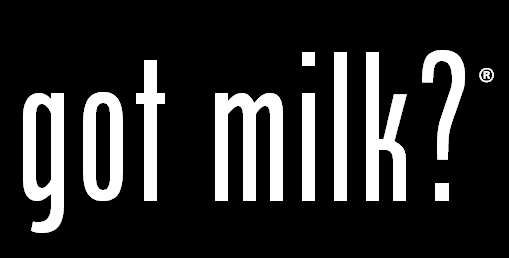

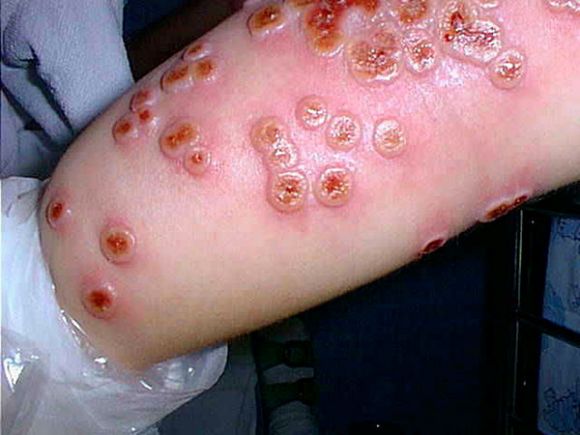

Comments